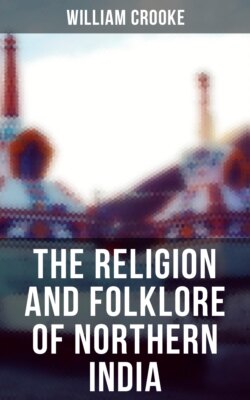Читать книгу The Religion and Folklore of Northern India - William Crooke - Страница 11
На сайте Литреса книга снята с продажи.
Village Worship of Sûraj Nârâyan.
ОглавлениеTable of Contents
The village worship of Sûraj Nârâyan is quite distinct from this. Many peasants in Upper India do not eat salt on Sundays, and do not set their milk for butter, but make rice-milk of it, and give a portion to Brâhmans. Brâhmans are sometimes fed in his honour at harvests, and the pious householder bows to him as he leaves his house in the morning. His more learned brethren repeat the Gâyatrî, that most ancient of Aryan prayers: “Tat savitur varenyam bhargo devasya dhîmahi, Dhiyo yo nah prachodayât” (“May we receive the glorious brightness of this, the generator, the God who shall prosper our works!”). In the chilly mornings of the cold weather you will hear the sleepy coolies as they wake, yawning and muttering Sûraj Nârâyan, as the yellow gleam of dawn spreads over the Eastern sky. In fact, even in Vedic times there seems to have been a local worship of Sûrya connected with some primitive folk-lore. Haradatta mentions as one of the customs not sanctioned in the Veda, that when the sun is in Aries the young girls would paint the sun with his retinue on the soil in coloured dust, and worship this in the morning and evening;16 and in Central India the sun was in the Middle Ages worshipped under the local form of Bhâilla, or “Lord of Life,” a term which appears to have been the origin of the name Bhilsa, known to more recent ages as a famous seat of Buddhism.17
At Udaypur in Râjputâna the sun has universal precedence. His portal (Sûryapul) is the chief entrance to the city; his name gives dignity to the chief apartment or hall (Sûryamahal) of the palace, and from the balcony of the sun (Sûrya-gokhru), the descendant of Râma shows himself in the dark monsoon as the sun’s representative. A large painted sun of gypsum in high relief with gilded rays adorns the hall of audience, and in front of it is the throne. The sacred standard bears his image, as does the disc (changî) of black felt or ostrich feathers with a plate of gold in its centre to represent the sun, borne aloft on a pole. The royal parasol is called Kiraniya, in allusion to its shape, like a ray (kiran) of the orb.18
Another famous centre of Sun-worship was Multân, where, as we have seen, a temple dedicated to him has been discovered, and where the tribes of the Bâlas and Kâthis were devoted to him. The worship continued till the idol was destroyed by orders of Aurangzeb.
